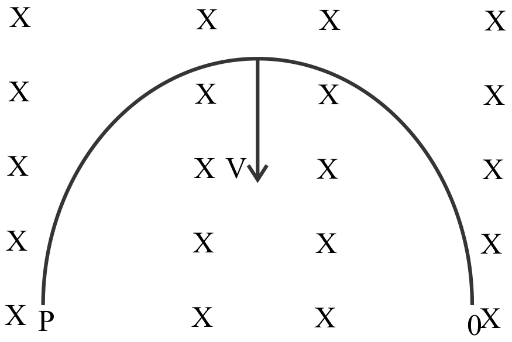
A semicircle loop PQ of radius $R$ is moved with velocity $v$ in transverse magnetic field as shown in fig. The value of induced emf at the end of the loop is

A. $Bv\pi R$ end P at high potential
B. $2BRv$end P at high potential
C. $2BRv$end Q at high potential
D. $\dfrac{{B\pi {R^2}v}}{2}$ end P at high potential
Answer
217.2k+ views
Hint: First put the above values in the formula for induced emf in a conductor moving with a given velocity. One important thing to consider is that the emf induced only depends upon the ends of the conductor and not the shape. Then using Fleming’s right hand rule, we can determine which end will have high potential.
Formula used:
$\varepsilon = Bvl$ where $\varepsilon $is the emf induced in the conductor of length $l$ when it moves in a magnetic field $B$ with velocity $v$.
$\varepsilon = - \dfrac{{d\Phi }}{{dt}}$ where $\Phi $ is the magnetic flux linked with the conductor.
Complete step by step solution
When a conductor of length $l$ is moving with a constant velocity $v$ in a magnetic field $\overrightarrow B $, an emf or a potential difference is induced between the two ends of the conductor. This emf is given as,
$\varepsilon = Bvl$when the conductor moves in a direction perpendicular to the magnetic field
Taking $l = 2R$ as the induced emf only depends upon the ends of a conductor.
Therefore, $\varepsilon = 2BRv$
Another way of calculating the emf induced within the conductor is by taking the time derivative of the magnetic flux linked with the conductor, which is given as,
$\varepsilon = - \dfrac{{d\Phi }}{{dt}}$
The magnetic flux through the conductor is given as,
$\Phi = BA$$ = Bldx$
So, $\varepsilon = - 2BR\dfrac{{dx}}{{dt}}$ [As induced emf only depends upon the ends of a conductor, $l = 2R$]
$ \Rightarrow \varepsilon = - 2BRv$
Taking the absolute value we get,
$\varepsilon = 2BRv$
This is the emf induced in the semicircular loop PQ.
Now, by using Fleming’s right hand rule which states that if we stretch the right-hand thumb and two nearby fingers perpendicular to one another, and the first finger points in the direction of the magnetic field and the thumb is in the direction of motion of the conductor, then the middle finger will point in the direction of the induced current, we can show that P is at low potential and Q is at high potential.
So, the correct option is C.
Note: The direction of the induced emf, or the current, in any circuit is such as to oppose the cause that produces it. This is known as Lenz’s law.
Formula used:
$\varepsilon = Bvl$ where $\varepsilon $is the emf induced in the conductor of length $l$ when it moves in a magnetic field $B$ with velocity $v$.
$\varepsilon = - \dfrac{{d\Phi }}{{dt}}$ where $\Phi $ is the magnetic flux linked with the conductor.
Complete step by step solution
When a conductor of length $l$ is moving with a constant velocity $v$ in a magnetic field $\overrightarrow B $, an emf or a potential difference is induced between the two ends of the conductor. This emf is given as,
$\varepsilon = Bvl$when the conductor moves in a direction perpendicular to the magnetic field
Taking $l = 2R$ as the induced emf only depends upon the ends of a conductor.
Therefore, $\varepsilon = 2BRv$
Another way of calculating the emf induced within the conductor is by taking the time derivative of the magnetic flux linked with the conductor, which is given as,
$\varepsilon = - \dfrac{{d\Phi }}{{dt}}$
The magnetic flux through the conductor is given as,
$\Phi = BA$$ = Bldx$
So, $\varepsilon = - 2BR\dfrac{{dx}}{{dt}}$ [As induced emf only depends upon the ends of a conductor, $l = 2R$]
$ \Rightarrow \varepsilon = - 2BRv$
Taking the absolute value we get,
$\varepsilon = 2BRv$
This is the emf induced in the semicircular loop PQ.
Now, by using Fleming’s right hand rule which states that if we stretch the right-hand thumb and two nearby fingers perpendicular to one another, and the first finger points in the direction of the magnetic field and the thumb is in the direction of motion of the conductor, then the middle finger will point in the direction of the induced current, we can show that P is at low potential and Q is at high potential.
So, the correct option is C.
Note: The direction of the induced emf, or the current, in any circuit is such as to oppose the cause that produces it. This is known as Lenz’s law.
Recently Updated Pages
Addition of Three Vectors: Methods & Examples

Addition of Vectors: Simple Guide for Students

Algebra Made Easy: Step-by-Step Guide for Students

Relations and Functions: Complete Guide for Students

Analytical Method of Vector Addition Explained Simply

Arithmetic, Geometric & Harmonic Progressions Explained

Trending doubts
JEE Main 2026: Application Form Open, Exam Dates, Syllabus, Eligibility & Question Papers

Derivation of Equation of Trajectory Explained for Students

Hybridisation in Chemistry – Concept, Types & Applications

Understanding the Angle of Deviation in a Prism

Understanding Collisions: Types and Examples for Students

How to Convert a Galvanometer into an Ammeter or Voltmeter

Other Pages
JEE Advanced Marks vs Ranks 2025: Understanding Category-wise Qualifying Marks and Previous Year Cut-offs

Understanding Atomic Structure for Beginners

Ideal and Non-Ideal Solutions Explained for Class 12 Chemistry

Degree of Dissociation: Meaning, Formula, Calculation & Uses

Understanding Electromagnetic Waves and Their Importance

Understanding the Electric Field of a Uniformly Charged Ring




